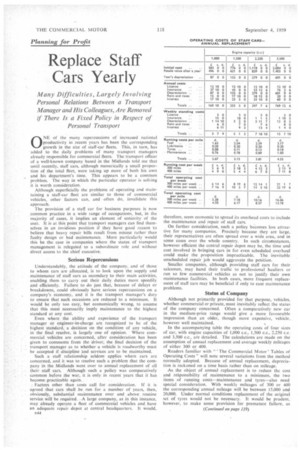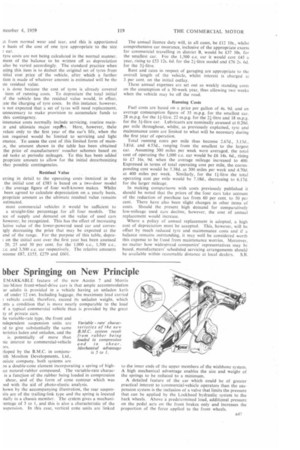Replace Staff Cars Yearly
Page 78

Page 81

If you've noticed an error in this article please click here to report it so we can fix it.
Many Difficulties, Largely Involving Personal Relations Between a Transport Manager and His Colleagues, Are Removed if There Is a Fixed Policy in Respect of Personal Transport
NE of the many repercussions of increased national C) productivity in recent years has been the corresponding growth in the size of staff-car fleets. This, in turn, has added to the daily problems of many transport managers already responsible for commercial fleets. The transport officer of a well-known company based in the Midlands told me that until recently, staff cars, although numerically a small proportion of the total fleet, were taking up more of both his own and his department's time. This appears to be a common problem. The way in which the particular operator is solving it is worth consideration.
Although superficially the problems of operating and maintaining a staff-car fleet are similar to those of commercial vehicles, other factors can, and often do, invalidate this approach.
The provision of a staff ear for business purposes is now common practice in a wide range of occupations, but, in the majority of cases, it implies an element of seniority of the user. It is at this point that transport managers can find themselves in an invidious position if they have good reason to believe that heavy repair bills result from misuse rather than faulty design or bad maintenance. More particularly would this be the case in companies where the status of transport management is relegated to a subordinate role and without direct access to the chief executive,
Serious Repercussions
Understandably, the attitude of the company. and or those to whom cars are allocated, is to took upon the supply and maintenance of staff cars as secondary to their main activities, enabling them to carry out their daily duties more speedily and efficiently. Failure to do just that, because of delays or breakdowns, could obviously have serious repercussions on a company's economy, and it is the transport manager's duty to ensure that such occasions are reduced to a minimum. It would be only too easy, but economically wrong, to assume that this must necessarily imply maintenance to the highest standard at any cost.
Even where the ability and experience of the transport manager or engineer-in-charge are recognized to be of the highest standard, a decision on the condition of any vehicle, in the final resolve, is largely one of opinion. Where commercial vehicles are concerned, after consideration has been given to comments from the driver, the final decision of the transport manager as to whether a vehicle is roadworthy must be accepted if discipline and services are to be maintained.
Such a staff relationship seldom applies where cars are concerned, and it was to resolve such a problem that the company in the Midlands went over to annual replacement of all their staff cars. Although such a policy was comparatively common before the war, it is only in recent years that it has become practicable again.
: Factors other than costs call for consideration. If it is agreed that cars shall be run for a number of years, then, obviously, substantial maintenance over and above routine service will be required. A large company, as in this instance, may already operate a fleet of commercial vehicles and have an adequate repair depot at central headquarters. It would.
rs44 therefore, seem economic to spread its overhead costs to include the maintenance and repair of staff cars.
On further consideration, such a policy becomes less attractive for many companies. Precisely because they are large, their representatives are often spread over a wide area, and in some cases over thc whole country. In such circumstances, however efficient the central repair depot may be, the time and cost involved in bringing cars in for even scheduled overhaul could make the proposition impracticable. The inevitable unscheduled repair job would aggravate the position.
Smaller companies, although providing staff cars for their salesmen, may hand their traffic to professional hauliers or run so few commercial vehicles as not to justify their own maintenance facilities. In both cases, more frequent replacement of staff cars may be beneficial if only to ease maintenance problems.
Status of Company
Although not primarily provided for that purpose, vehicles, whether commercial or private, must inevitably reflect the status of the company concerned. Often a comparatively new car in the medium-price range would give a more favourable impression than an older, though more expensive, vehicle. however well maintained.
In the accompanying table the operating costs of four sizes of car, with engine capacities of 1,000 c.c., L500 c.c., 2,250 c.c. and 3,500 c.c., are detailed, The calculations are made on the assumption of annual replacement and average weekly mileages of either 300 or 400.
Readers familiar with "' The Commercial Motor' Tables of Operating Costs" will note several variations from the method normally adopted. Because of annual replacement, depreciation is reckoned on a time basis rather than on mileage.
As the object of annual replacement is to reduce the cost and responsibility of maintenance to a minimum, the two items of running costs-maintenance and tyres-also need special consideration. With weekly mileages of 300 or 400 the corresponding annual mileage will be between 15.000 and 20,000. Under normal conditions replacement of the original set of tyres would not be necessary. It would be prudent. however, to make some provision for premature failure. as ;t from normal wear and tear, and this is apportioned e basis of the cost of one tyre appropriate to the size ; car.
tyre costs arc not being calculated in the normal manner. ment of the balance to be written off as depreciation also be varied accordingly. The standard practice when ating this item is to deduct the original set of tyres from aitial cost price of the vehicle, after which a further tion is made of whatever amount is estimated will be the ite residual value.
s is done because the cost of tyres is already covered item of running costs. To depreciate the total initial af the vehicle less the residual value would, in effect. :ate the charging of tyre costs. In this instance, however, is not expected that a set of tyres will need replacement, unnecessary to make provision to accumulate funds to this contingency.
intenance costs normally include servicing, routine main:e and ultimate major reptlirs. Here, however, these relate only to the first year of the car's life, when the ion required would be *limited to servicing and light mance. To assess the cost of this limited form of main-;e, the amount shown in the table has been obtained the price of manufacturers' voucher schemes based on ed tasks at periodic mileages. To this has been added propriate amount to allow for the initial decarbonizing ther possible contingencies.
Residual Value erring in detail to the operating costs itemized in the the initial cost of £583 is based on a two-door model ; the average figure of four well-known makes. Whilst been agreed to calculate depreciation on a. yearly basis, propriate amount as the ultimate residual value remains estimated.
most commercial vehicles it would be sufficient to a straight-line percentage for all four models. The Ice of supply and demand on the value of used cars however, be recognized. This has the effect of increasing lative value of the lower-powered used car and cormstgly decreasing the price that may be expected at the end of the range. For the purpose of this table, depre t on the initial cost over the first year has been assessed 20, 25 and 30 per cent, for the 1,000 c.c., 1,500 c.c., ;.c. and 3,500 c.c. car respectively. The relative amounts occome £87, £155, £279 and £601.
The annual licence duty will, in all cases, be £12 10s., whilst comprehensive car insurance, inclusive of the appropriate excess for commercial travelling in district B, would be £37 10s. for the smallest car. For the 1,500 c.c. car it would cost £45 a year, rising to £53 12s. 6d. for the 21-1itre model and £76 2s. 6d. for the 31-litre.
Rent and rates in respect of garaging are appropriate to the overall length of the vehicle, whilst interest is charged at 3 per cent, on the initial outlay.
These annual expenses arc set out as weekly standing costs on the assumption of a 50-week year, thus allowing two weeks when the vehicle may be off the road.
Running Costs Fuel costs are based on a price per gallon of 4s. 9d. and an average consumption figure of 35 m.p.g. for the smallest car. 28 m.p.g. for the 11-litre. 22 m.p.g. for the 21-litre and 18 m.p.g. for the *litre car, Lubricants are nominally assessed at 0.20d. per mile throughout, whilst, as previously explained, tyre and maintenance costs are limited to what will be necessary during the first year of operation.
Total running costs per mile thus become 2.67d., 3.13d., 3.81d. and 4.55d., ranging from the smallest to the largest car. Assuming 300 miles per week were averaged, the total cost of operating the 1,000 c.c. car would be £6 14s. 64., rising to £7 16s. 9d. when the average mileage increased to 400. Expressed in terms of total operating cost per mile, the corresponding cost would be 5.38d. at 300 miles per week and 4.70d. at 400 miles per week. Similarly, for the li-litre the total operating cost per mile would he 7.18d., decreasing to 6.17d. for the larger mileage.
In making comparisons with costs previously published it should be noted that the prices of the four cars take account of the reduction of purchase tax from 60 per cent. to 50 per cent. There have also been slight changes in other items of costs. Should the present high demand for comparatively low-mileage used cars decline, however, the cost of annual replacement would increase.
Where a policy of annual replacement is adopted, a high cost of depreciation must be accepted. This, however, will be offset by much reduced tyre and maintenance costs and if a balance remains outstanding, it may well be considered worth this expense to be freed from maintenance worries. Moreover. no matter how widespread companies' representatives may be based, manufacturers' scheduled servicing arrangements should be available within reasonable distance at local dealers. S.B.




















































































































